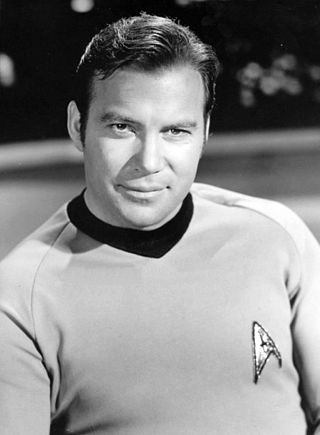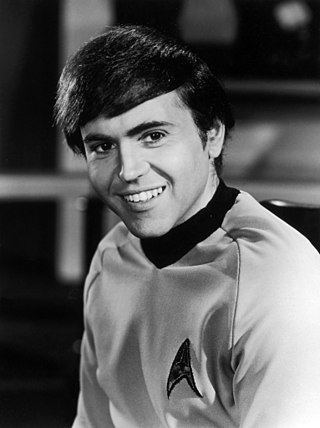
James Tiberius Kirk, commonly known as James T. Kirk or Captain Kirk, is a fictional character in the Star Trek media franchise. Originally played by Canadian actor William Shatner, Kirk first appeared in Star Trek serving aboard the starship USS Enterprise as captain. Kirk leads his crew as they explore new worlds, new civilizations, and "boldly go where no man has gone before". Often, the characters of Spock and Leonard "Bones" McCoy act as his logical and emotional sounding boards, respectively. Kirk has also been portrayed in numerous films, books, comics, webisodes, and video games.

Spock is a fictional character in the Star Trek media franchise. He first appeared in the original Star Trek series serving aboard the starship USS Enterprise as science officer and first officer and later as commanding officer of the vessel. Spock's mixed human–Vulcan heritage serves as an important plot element in many of the character's appearances. Along with Captain James T. Kirk and Dr. Leonard "Bones" McCoy, he is one of the three central characters in the original Star Trek series and its films. After retiring from active duty in Starfleet, Spock served as a Federation ambassador, and later became involved in the ill-fated attempt to save Romulus from a supernova, leading him to live out the rest of his life in a parallel universe.

Nyota Uhura, or simply Uhura, is a fictional character in the Star Trek franchise. In the original television series, the character was portrayed by Nichelle Nichols, who reprised the role for the first six Star Trek feature films. A younger Uhura is portrayed by Celia Rose Gooding in the 2022 prequel series Star Trek: Strange New Worlds, while an alternate timeline version of Uhura has been portrayed by actress Zoe Saldaña in the feature films Star Trek (2009), Star Trek Into Darkness (2013), and Star Trek Beyond (2016).

Pavel Andreievich Chekov is a fictional character in the Star Trek universe.

Hikaru Kato Sulu is a fictional character in the Star Trek media franchise. A member of the crew in the original Star Trek series, Sulu also appears in the animated Star Trek series, in the first six Star Trek movies, in one episode of Star Trek: Voyager, and in several books, comics, and video games. Originally known simply as "Sulu", his first name, "Hikaru", appeared in a 1981 novel well over a decade after the original series had ended.
"The City on the Edge of Forever" is the twenty-eighth and penultimate episode of the first season of the American science fiction television series Star Trek. It was written by Harlan Ellison; contributors to and/or editors of the script included Steven W. Carabatsos, D. C. Fontana and Gene L. Coon. Gene Roddenberry made the final re-write. The episode was directed by Joseph Pevney and first aired on NBC on April 6, 1967, with a repeat broadcast on August 31, 1967.

"Where No Man Has Gone Before" is the third episode of the first season of the American science-fiction television series Star Trek. Written by Samuel A. Peeples and directed by James Goldstone, it first aired on September 22, 1966.

Christine Chapel is a fictional character who appears in all three seasons of the American science fiction television series Star Trek: The Original Series, as well as Star Trek: The Animated Series and the films Star Trek: The Motion Picture and Star Trek IV: The Voyage Home. Portrayed by Majel Barrett, she was the ship's nurse on board the Starfleet starship USS Enterprise. A younger version of Chapel appears in the 2022 series Star Trek: Strange New Worlds, portrayed by Jess Bush.
"Space Seed" is the 22nd episode of the first season of the American science fiction television series Star Trek. It was first broadcast by NBC on February 16, 1967. "Space Seed" was written by Gene L. Coon and Carey Wilber and directed by Marc Daniels.

Montgomery "Scotty" Scott is a fictional character in the science fiction franchise Star Trek. First portrayed by James Doohan in the original Star Trek series, Scotty also appears in the animated Star Trek series, 10 Star Trek films, the Star Trek: The Next Generation episode "Relics", and in numerous books, comics, and video games.

Janice Rand is a fictional character in the American science fiction television series Star Trek: The Original Series during its first season, as well as three of the Star Trek films. She is the Captain's yeoman on board the USS Enterprise (NCC-1701), and first appeared in the episode "The Man Trap". She had significant roles in the episodes "The Enemy Within", where she fights off an evil version of Captain James T. Kirk; "Charlie X" where a young man with god-like powers falls in love with her; and "Miri" where she is infected with a deadly disease while on an away mission and is kidnapped by jealous children.
"Charlie X" is the second episode of the first season of the American science fiction television series Star Trek. Written by Dorothy C. Fontana from a story by Gene Roddenberry, and directed by Lawrence Dobkin, it first aired on September 15, 1966.
"The Man Trap" is the first episode of season one of the American science fiction television series Star Trek. Written by George Clayton Johnson and directed by Marc Daniels, it featured design work by Wah Chang and first aired in the United States on September 8, 1966.
"What Are Little Girls Made Of?" is the seventh episode of the first season of the American science fiction television series, Star Trek. Written by Robert Bloch and directed by James Goldstone, it first aired on October 20, 1966.
"The Deadly Years" is the twelfth episode of the second season of the American science fiction television series Star Trek. Written by David P. Harmon and directed by Joseph Pevney, it was first broadcast December 8, 1967.
"The Omega Glory" is the twenty-third episode of the second season of the American science fiction television series Star Trek. Written by Gene Roddenberry and directed by Vincent McEveety, it was first broadcast March 1, 1968. In the episode, Captain Kirk must find the cure to a deadly disease and put an end to another Starfleet captain's cultural interference. The story was one of three outlines submitted for selection as the second pilot of Star Trek, the others being "Mudd's Women" and "Where No Man Has Gone Before".
"The Empath" is the twelfth episode of the third season of the American science fiction television series Star Trek. Written by Joyce Muskat and directed by John Erman, it was first broadcast on December 6, 1968.
"Turnabout Intruder" is the twenty-fourth and final episode of the third season of the American science fiction television series Star Trek. Written by Arthur H. Singer and directed by Herb Wallerstein, it was first broadcast on June 3, 1969.
"The Survivor" is the sixth episode of the first season of the American animated science fiction television series Star Trek: The Animated Series. It first aired on NBC on October 13, 1973, and was written by James Schmerer and directed by Hal Sutherland. Schmerer pitched an idea for an episode to producer D.C. Fontana called "The Chameleon", and together with the series creator Gene Roddenberry, it was developed into the final script.

The development of Spock, a fictional character first introduced in the American science fiction television series Star Trek, began prior to the start of the series. The first known mention of Spock was in a discussion between Gene Roddenberry and Gary Lockwood, where the latter suggested Leonard Nimoy for the role. Roddenberry agreed with the suggestion, and Nimoy became the first choice actor for the part. However, Roddenberry was required to audition other actors for the role. It was offered to both DeForest Kelley and Martin Landau before Nimoy. Nimoy disliked the prosthetic ears he was required to wear, and there were concerns from the studio that they made him appear satanic. Roddenberry fought to keep the character in the second pilot, "Where No Man Has Gone Before" after the rest of the main cast was dropped from the initial pilot, "The Cage".











